Bucephalandra is a fascinating aquatic plant that adds a touch of beauty to any aquarium. One of its notable features is its ability to thrive without being planted in substrate; instead, it can attach easily to stones and driftwood.
There are numerous varieties of bucephalandra, each with its own unique appearance and characteristics. Commercial names for these varieties often reflect their place of origin, leaf color, or other distinguishing features. Despite this diversity, only a few species have been formally recognized by the scientific community and classified under a specific bucephalandra category.
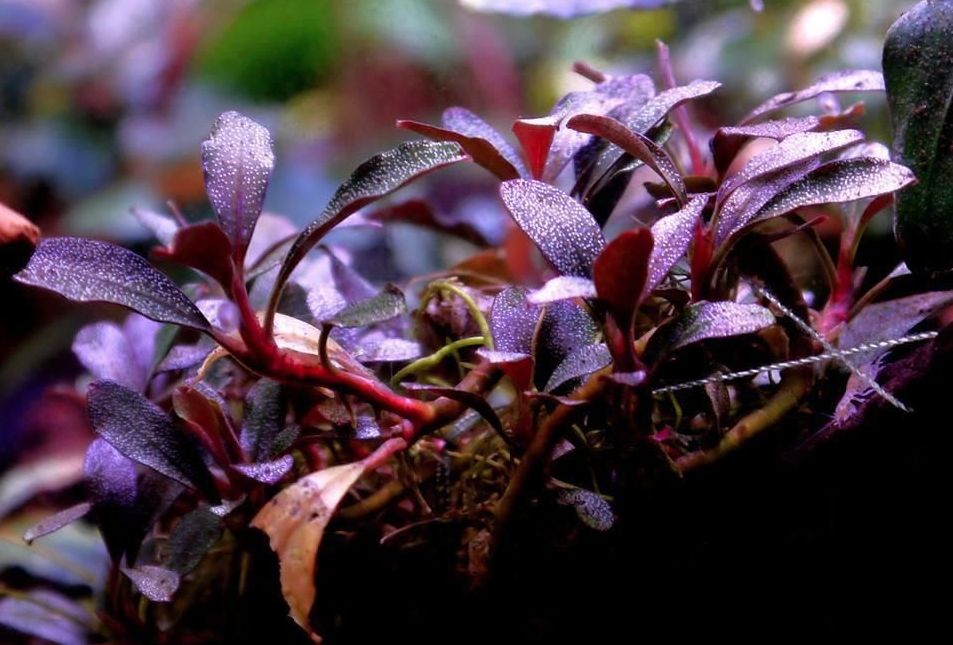
Contents
Plant Habitat in the wild
Bucephalandra is a kind of paludal plants of Araceae family which adapted to dwell in flowing waters. The name of the kind – Bucephalandra is connected with the name of the horse of Alexander the Great – Bucephalus (Bous + kephale = Βουκέφαλος, Bukefalos). “Βous” and “kephale” mean “a bull” and “a head”. Appearance of staminate flower of Bucephalandra also resembles a bull’s head.
In botanics these plants have been known since 1858. Bucephalandra appeared in aquarium husbandry in 2005 and became very popular right away. Up to now new variations of the plant appear and they haven’t been described in botanic textbooks yet. All of them are endemic species of Borneo island and they grow mainly in fast flowing rivers and streams, and seldom along the riverbanks. The plant blooms generally under water. Borneo island has tropical climate and average annual temperature there is higher than 20°C.
Seasonality is typical for the island, when amount of precipitation differs by times. During rain season water level in rivers rises and Bucephalandra stays under water for several months. Nevertheless, the plant continues growing and it can easily transform into its submerged form. During dry season the plant can grow taking its emersed form.
Basic difference between the submerged and emersed form of the plant is that when they grow under water structure of the leaves is thinner and they have more saturated color. Bucephalandra plants are primarily found in the rivers and streams of Borneo. They grow attached to rocks, driftwood, or other submerged surfaces in the water. These plants are adapted to the low-light conditions and slow water movement typical of their natural habitat.
Unfortunately, Bucephalandra gradually disappear from our environment basically due to forests exploitation and deforestation of Borneo island. It gets more difficult to find some species and some of them exist only in captivity nowadays. Keeping these plants in a tank may be useful for long-term species survival, since many areas of Borneo island suffer from deforestation now.
Bucephalandra commercial names may be a speculative article, since suppliers which give the plants these names want to increase their collection and don’t take taxonomy of plants as seriously as scientists do. However, these names of the plant kinds yet remain just commercial names and they have nothing to do with the botanic names.
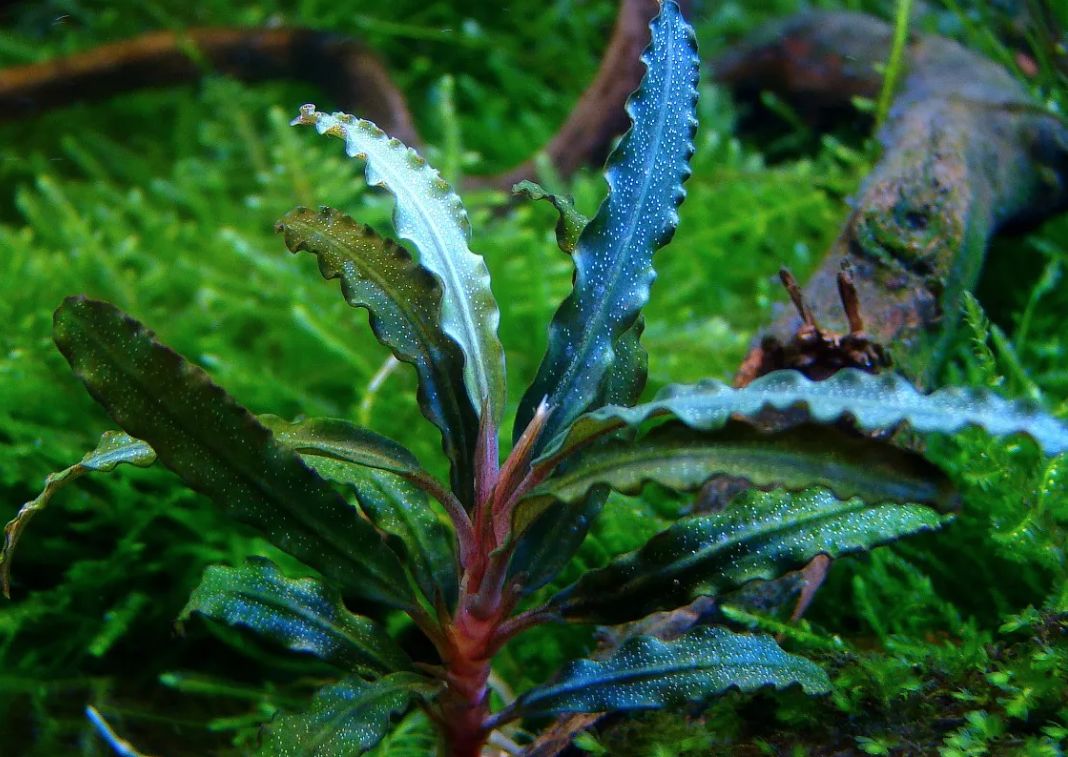
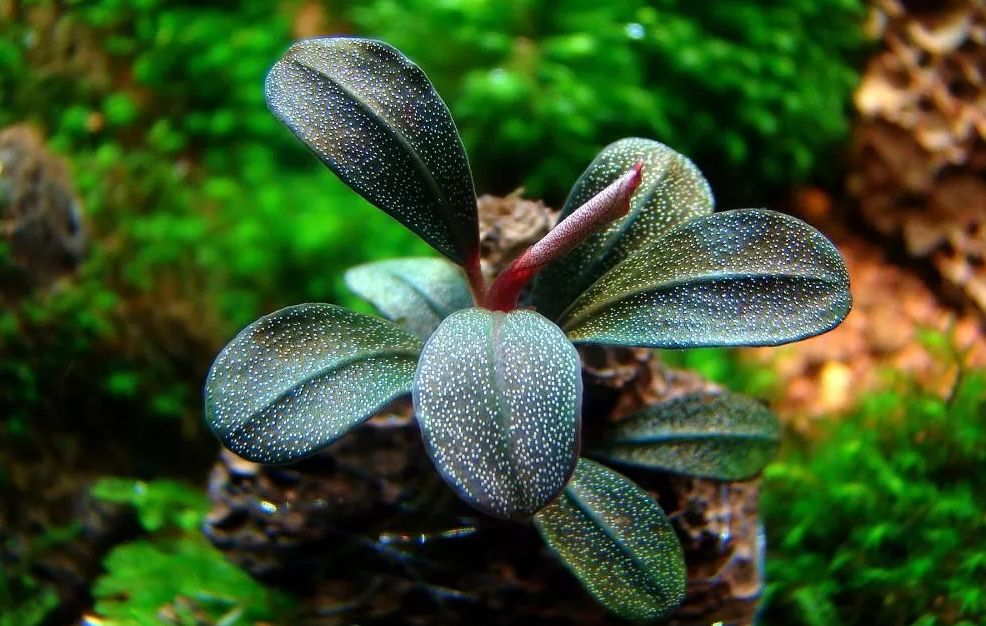
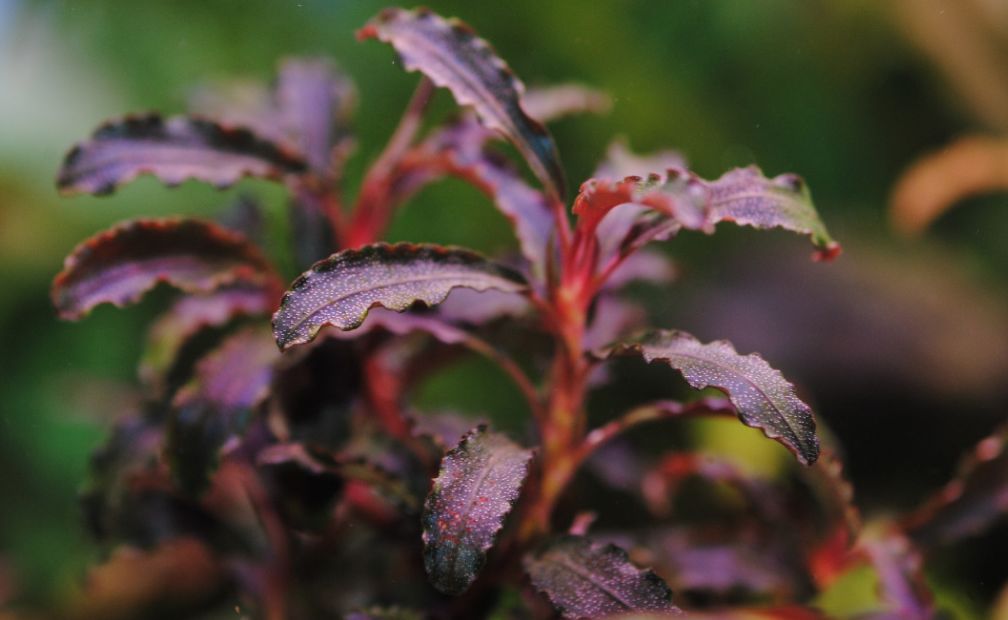
Description
Due to the species variety and absence of scientific classification as well as a mess in commercial names of the plant it seems impossible to describe it.
Bucephalandra may differ sufficiently in size, shape and leaves color. The leaves can range from small and lanceolate to larger and oval. The coloration varies from shades of green to deep purples, reds, and even metallic hues. Some species also exhibit attractive patterns or veining on their leaves. Experts can distinguish patterns of the plant lamina and divide similar Bucephalandra into different kinds.
Besides, proper classification is also complicated by the fact that at various conditions one and the same plant my have different appearance when changing its color and leaves shape.
Bucephalandra is a small sized plant as a rule. Most of the species grow up to 3-5 cm high. But there are many plants that grow large (8-15 cm high) and even larger (up to 25 cm high).
Distinctive and recognizable feature of all Bucephalandra is presence of bright spots on the leaves, which many aquarists mistakenly take for air bubbles that appear as a result of photosynthesis. These spots are encountered in most of arum family plant kinds.
Depending on its kind the plant may have more or less spots on its leaves. You can observe similar spots on Anubias species, but they aren’t that visible. Submerged forms of Bucephalandra have less visible spots and their number increases when the plant grows under water.
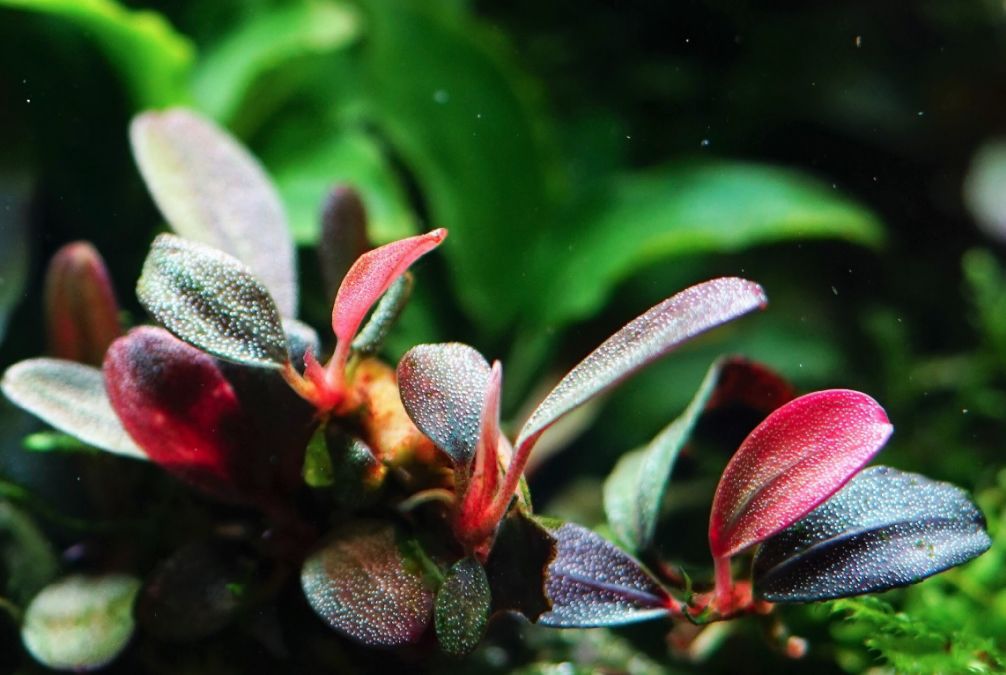
types of bucephalandra
Here are some notable types of Bucephalandra:
Bucephalandra ‘Wavy green’
Bucephalandra ‘Wavy Green’ is a specific variety of Bucephalandra known for its wavy green leaves. It is highly sought after in the aquarium hobby due to its unique leaf shape and vibrant green coloration. The wavy edges of the leaves add a distinctive texture and visual interest to planted aquariums. ‘Wavy Green’ is a versatile plant that can be used as a focal point or as part of a lush green carpet in aquascaping layouts. Its hardy nature and slow growth make it suitable for both beginners and experienced aquarists.

| Characteristic | Description |
|---|---|
| Leaf Color | Vibrant green |
| Leaf Shape | Wavy edges |
| Growth Rate | Slow |
| Size | Compact and relatively small |
| Lighting Requirements | Moderate to high light conditions |
| CO2 Requirement | Low to moderate CO2 supplementation |
| Water Parameters | pH: 6.0-7.5 Temperature: 22-28°C (72-82°F) Soft to medium water hardness |
| Propagation | Rhizome division, new shoots from the rhizome |
| Difficulty Level | Beginner to intermediate |
| Placement in Tank | Foreground or midground placement |
| Suitable for | Freshwater planted aquariums with appropriate water parameters |
Bucephalandra ‘Brownie Ghost’

The leaves of ‘Brownie Ghost’ range from light to dark brown, often with hints of copper or bronze. This coloration gives the plant an intriguing and eye-catching look. The leaves are typically lanceolate or elliptical in shape, elongated. They may exhibit a slight wave or curve along the edges, adding to their visual appeal. This variety of Bucephalandra remains relatively small, with leaves typically reaching a few inches in length. Its compact size makes it suitable for placement in the foreground or midground of an aquascape.
| Characteristic | Description |
|---|---|
| Leaf Color | Light to dark brown with hints of copper or bronze |
| Leaf Shape | Lanceolate or elliptical |
| Growth Rate | Slow |
| Size | Compact and relatively small |
| Lighting Requirements | Moderate to high light conditions |
| CO2 Requirement | Low to moderate CO2 supplementation |
| Water Parameters | pH: 6.0-7.5 Temperature: 22-28°C (72-82°F) Soft to medium water hardness |
| Propagation | Rhizome division, new shoots from the rhizome |
| Difficulty Level | Beginner to intermediate |
| Placement in Tank | Foreground or midground placement |
| Suitable for | Freshwater planted aquariums with appropriate water parameters |
Bucephalandra ‘Brownie Purple’
The leaves of ‘Brownie Purple’ exhibit a deep purple coloration, ranging from dark plum to rich violet. This intense hue adds a captivating and visually stunning element to aquariums. ‘Brownie Purple’ is typically placed in the foreground or midground areas of an aquarium, where its vibrant purple foliage can be prominently displayed.
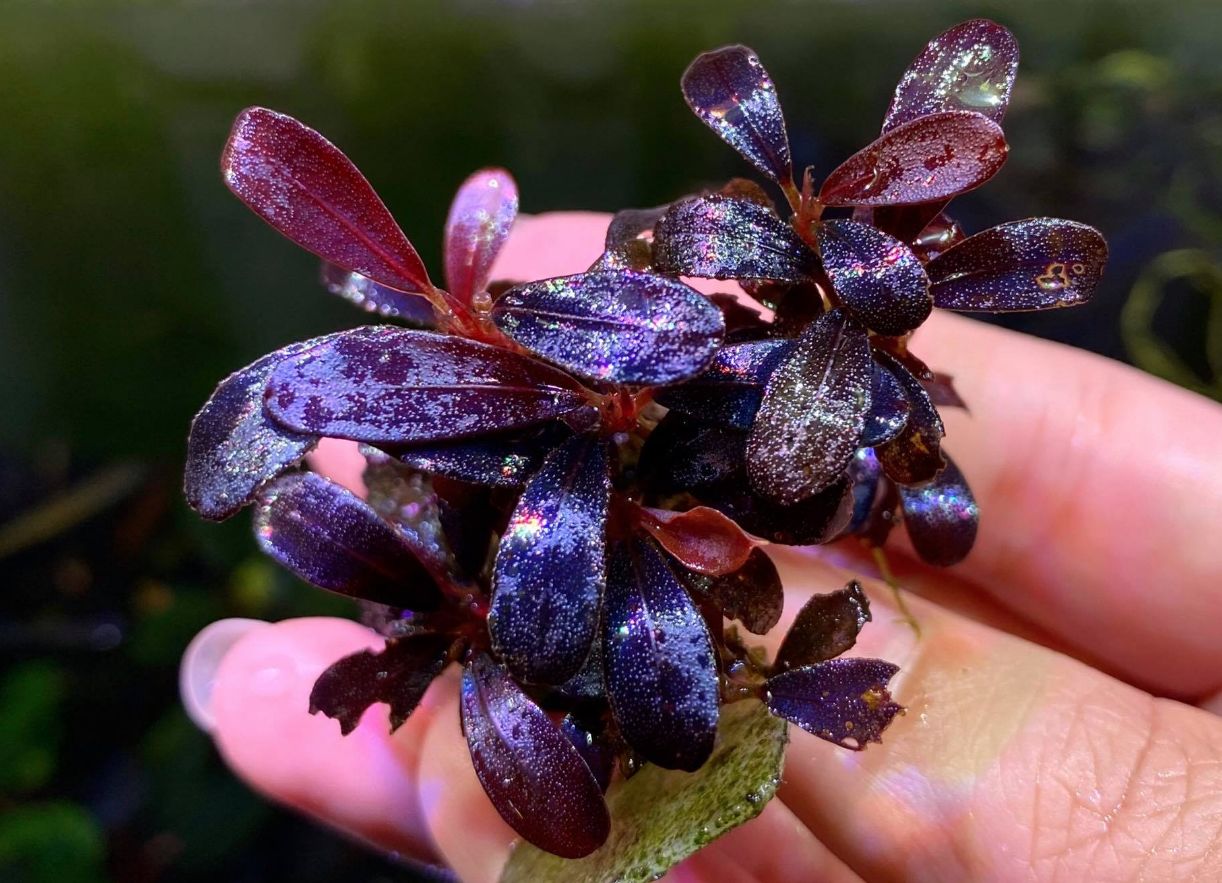
| Characteristic | Description |
|---|---|
| Leaf Color | Deep purple, ranging from dark plum to rich violet |
| Leaf Shape | Lanceolate or elliptical |
| Growth Rate | Slow |
| Size | Compact and relatively small |
| Lighting Requirements | Moderate to high light conditions |
| CO2 Requirement | Low to moderate CO2 supplementation |
| Water Parameters | pH: 6.0-7.5 Temperature: 22-28°C (72-82°F) Soft to medium water hardness |
| Propagation | Rhizome division, new shoots from the rhizome |
| Difficulty Level | Beginner to intermediate |
| Placement in Tank | Foreground or midground placement |
| Suitable for | Freshwater planted aquariums with appropriate water parameters |
Bucephalandra ‘godzilla’
This “Godzilla” was named for its longish dark-green, curved, and ridged leaves that exhibit a blue sheen and tons of scale-like silvery dots. This species of Buce is medium-sized and like all other species, is a great beginner plant for its easy care and beautiful appearance.
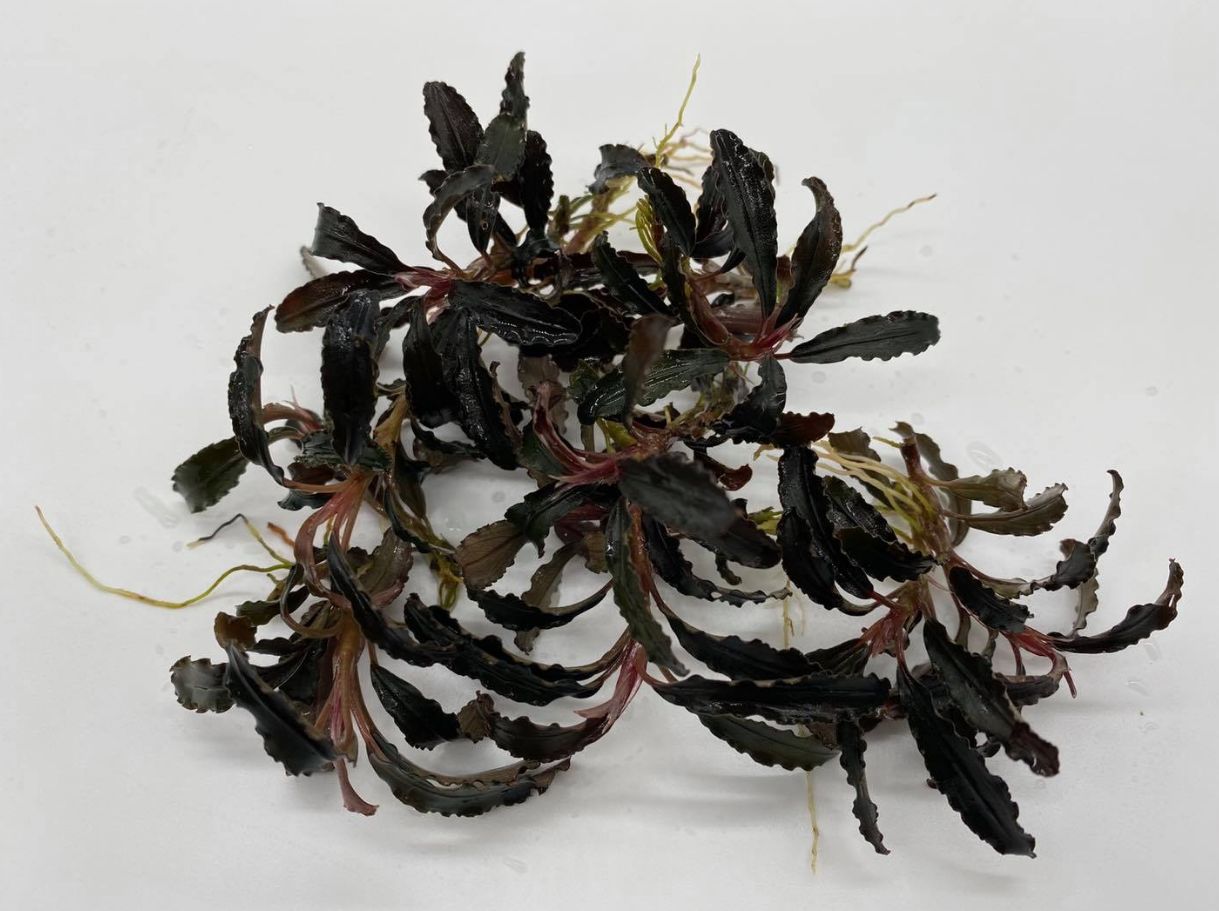
Difficulties in keeping
There is a view that Bucephalandra is easy to keep in a tank. However, this isn’t so. In general, species are quite enduring, but still it’s better to consider them as those of medium difficulty in keeping. Though, some species may be quite challenging to keep.
In the real life many beginner aquarists, who have no problem in keeping Anubias and Cryptocoryne species find it challenging to grow species.
Bucephalandra growth rate
Bucephalandra plants are relatively slow-growing compared to many other aquarium plants. It can take several months for new leaves to develop and fully unfurl. This slow growth rate often makes Bucephalandra a desirable plant for aquascaping, as it maintains its compact form and requires less frequent trimming. The growth rate depends on the plant kind. Some kinds can shoot 2 new leaves in a week if they are provided with proper growth conditions, while the others will shoot just one leaf each 2 weeks.These are slow-growing plants, but if you provide them with enough of bright lighting, fertilizers and large amount of CO2, you will get the highest growth rate.
To ensure bright coloring of the plant you will need bright tank lighting and proper fertilizers. Even small amount of CO2 and fertilizers can improve the plant growth pace and its coloring intensity.
Bucephalandra plants possess a creeping rhizome that grows horizontally and anchors the plant to its substrate. The rhizome gives rise to new leaves and roots, allowing the plant to spread gradually. Over time, a clump of plants can form a visually striking carpet or cluster in the aquarium.
Bucephalandra holes in leaves
Even experts in Bucephalandra cultivating very often can’t avoid the problem, which is very common for this plant – appearance of round holes in the leaf blade. At that, it isn’t due to lack of potassium in the tank water, which is true for most of the tank plants.
You can see, that the problem is quite widespread from the fact, that even in pictures that sellers show, you can often see these holes in the leaves. They may be large and small both on new and old leaves. At that, the leaf with such a hole doesn’t die and the whole plant looks healthy and successfully grows.
Care and propagation in a tank
Water parameters
For optimal growth, bucephalandra thrives in the following water parameters:
- Temperature: Maintain a range of 72°F to 82°F (22°C to 28°C). This temperature range suits most tropical aquarium setups and supports healthy plant growth.
- pH: prefers slightly acidic to slightly alkaline conditions. The ideal pH range is between 6.0 and 7.5. Consistent pH levels are crucial to avoid stressing the plants.
- General Hardness (GH) and Carbonate Hardness (KH): plant is adaptable to a wide range of water hardness. Ideally, the GH should be between 4 and 12 dGH, and the KH should be between 2 and 6 dKH. This flexibility allows the plant to thrive in both soft and hard water conditions.
Lighting
The plant isn’t that demanding in terms of tank lighting and it can dwell in quite shadowed areas of the tank. Even provided with minimal amount of light Bucephalandra will continue growing and shooting new leaves, but its coloring won’t be that bright and attractive. They can thrive under moderate to high lighting conditions. It’s best to provide them with a full spectrum of light, including both blue and red wavelengths, to support healthy growth.
Nutrients
Bucephalandra plants require a balanced supply of macro and micronutrients. Macronutrients include nitrogen (N), phosphorus (P), and potassium (K), while micronutrients encompass trace elements like iron (Fe), manganese (Mn), zinc (Zn), and others. Fertilizers formulated specifically for aquatic plants often contain these essential nutrients in balanced ratios.
Water Flow
Since in the wild plants grows in fast flowing rivers, it’s important to provide it with moderate water circulation in a tank. This is easy to do using a external filter and then put the plants along the water flow. The problem is, that usually this is the favorite place for algae to grow, especially black beard. Algae fouling is fatal both for Bucephalandra and Anubias species. Therefore, try to avoid organic accumulation and algae foiling in a tank where Bucephalandra grows.
Substrate
They are typically epiphytic, which means they grow attached to rocks, driftwood, or other surfaces rather than rooted in the substrate. In tanks the plant demonstrates better growth pace on solid surfaces such as various rocks, snags, coconut shells. Its roots stick to these surfaces ideally even if it is a granite surface.
However, providing a fine-grained substrate can still be beneficial as it helps anchor the rhizomes and provides a base for the plants to establish themselves. Fine-grained substrates like aquarium sand or fine gravel are suitable choices.
Bucephalandra plants do not have specific requirements for substrate composition. You can choose either inert or active substrates based on your preference and the needs of other plants or aquatic animals in your aquarium. Inert substrates like aquarium sand or gravel do not significantly affect the water chemistry. Active substrates, such as specialized plant substrates or soil-based substrates, can provide additional nutrients for plant growth.
CO2
While not essential, providing additional carbon dioxide (CO2) in a high-tech planted aquarium setup can enhance the growth of plants. CO2 supplementation helps plants utilize nutrients more efficiently and promotes faster growth. However, plants can also survive without added CO2 if other conditions are met. You shouldn’t expect Bucephalandra to grow in hard water without CO2 supply. The plant prefers soft water with hardness value up to 6 degrees KH and in water with such parameters it can grow even without CO2 supply